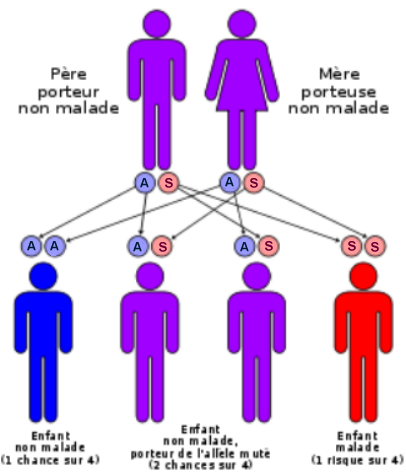
Transmission
- Post by: creativemood
- 30 June 2015
- No Comment
It is an autosomal recessive disease , that is to say, for the disease to appear , two copies of the mutated gene must be transmitted , one from the mother and one from the father. A child with two copies of the mutation is called homozygous SS.
When a single copy of the mutated gene (called S allele ) is present , the child is heterozygous AS , that is to say, he is not suffering from sickle cell disease. It may transmit the mutation to his future descent.
The genetic mutation involved in the synthesis of abnormal haemoglobin associated with sickle cell disease would have appeared there for thousands of years in sub-Saharan Africa population , and probably India population too, heavily exposed to the malaria by conferring bearer ( one copy of the mutated gene ) some protection against the malaria parasite which the target cell is the red blood cell and transmitted by the female Anopheles mosquito.
Transmission Mode of sickle cell anemia : autosomal recessive disease
The term ” Autosomal ” means that the two genes involved in the disease are located on one of the 22 pairs of chromosomes other than the sex chromosomes ( X and Y) , the ” autosomes “. The disease can appear as well than a girl than a boy. Everyone carries two copies of each gene : one copy inherited from the mother and one copy inherited from the father. The term ” recessive ” means that two copies of the gene must be altered for the disease appears. Thus, the parents of a child with the disease are perhaps not ill themselves, but they are both “carriers” of at least one copy of the defective gene (they are heterozygous AS, cf. see below). In this case, the risk of having a child achieves of the sickle cell disease for a couple where both parents are “carriers”, is of one on four in every pregnancy.
Both parents carry the mutated gene (“S “), are not sick (but heterozygotes) .
The child S/S has recovered the two mutated genes of his father and his mother is sickle cell disease ( homozygous SS).
Children A/S are not sick but are carriers of the mutated gene and can pass on to their descent.
The child A / A has no inherited mutated gene, either that of her mother or that of his father, he has two non- mutated genes ; he is not sick and no risk of transmitting disease.
Source : http://www.has-sante.fr/portail/jcms/c_1728538/fr/depistage-neonatal-de-la-drepanocytose-en-france


